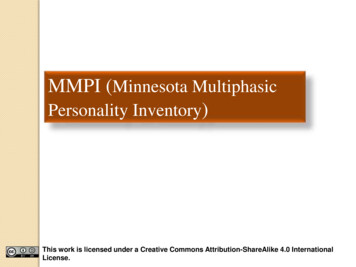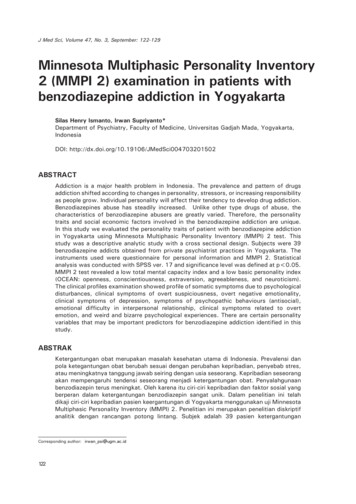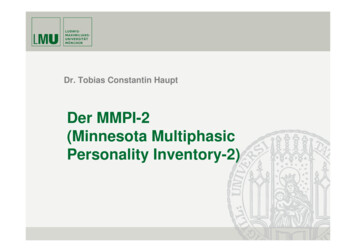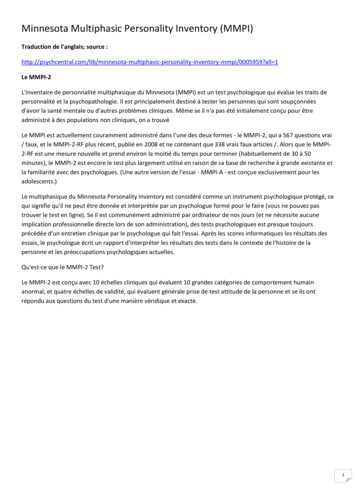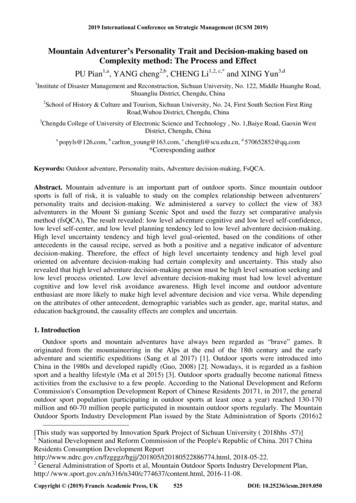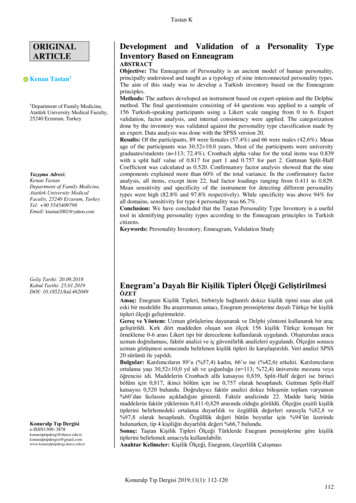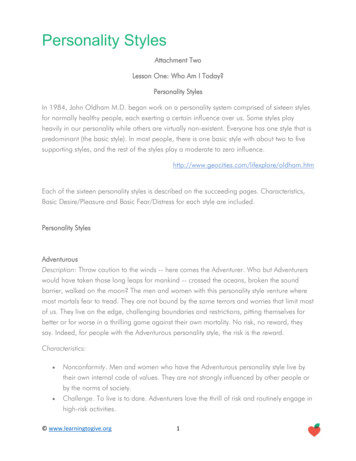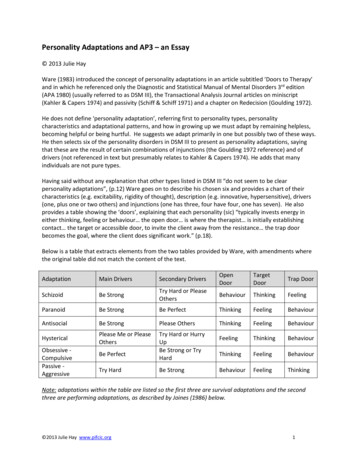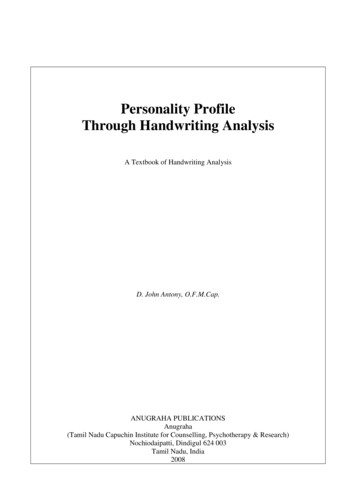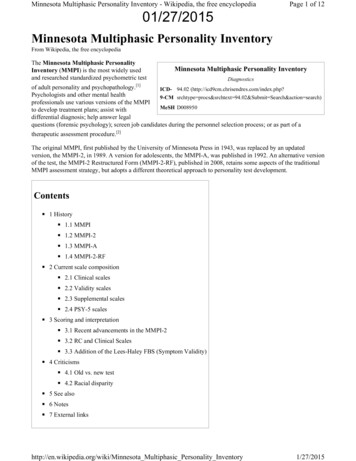
Transcription
Minnesota Multiphasic Personality Inventory - Wikipedia, the free encyclopedia01/27/2015Page 1 of 12Minnesota Multiphasic Personality InventoryFrom Wikipedia, the free encyclopediaThe Minnesota Multiphasic PersonalityInventory (MMPI) is the most widely usedand researched standardized psychometric testMinnesota Multiphasic Personality InventoryDiagnostics[1]of adult personality and psychopathology.ICD- 94.02 ists and other mental health9-CM srchtype procs&srchtext 94.02&Submit Search&action search)professionals use various versions of the MMPIMeSH D008950to develop treatment plans; assist withdifferential diagnosis; help answer legalquestions (forensic psychology); screen job candidates during the personnel selection process; or as part of atherapeutic assessment procedure.[2]The original MMPI, first published by the University of Minnesota Press in 1943, was replaced by an updatedversion, the MMPI-2, in 1989. A version for adolescents, the MMPI-A, was published in 1992. An alternative versionof the test, the MMPI-2 Restructured Form (MMPI-2-RF), published in 2008, retains some aspects of the traditionalMMPI assessment strategy, but adopts a different theoretical approach to personality test development.Contents 1 History 1.1 MMPI 1.2 MMPI-2 1.3 MMPI-A 1.4 MMPI-2-RF 2 Current scale composition 2.1 Clinical scales 2.2 Validity scales 2.3 Supplemental scales 2.4 PSY-5 scales 3 Scoring and interpretation 3.1 Recent advancements in the MMPI-2 3.2 RC and Clinical Scales 3.3 Addition of the Lees-Haley FBS (Symptom Validity) 4 Criticisms 4.1 Old vs. new test 4.2 Racial disparity 5 See also 6 Notes 7 External linkshttp://en.wikipedia.org/wiki/Minnesota Multiphasic Personality Inventory1/27/2015
Minnesota Multiphasic Personality Inventory - Wikipedia, the free encyclopedia01/27/2015Page 2 of 12HistoryThe original authors of the MMPI were Starke R. Hathaway, PhD, and J. C. McKinley, MD. The MMPI iscopyrighted by the University of Minnesota.The MMPI has been considered the gold standard in personality testing ever since its inception as an adult measure ofpsychopathology and personality structure in 1939. Many additions and changes to the measure have been made overtime, including the addition of dozens of supplemental, validity, and other content scales to improve interpretabilityof the original Clinical Scales, changes in the number of items in the measure, and other adjustments. The mosthistorically significant developmental changes include: In 1989, the MMPI became the MMPI-2 as a result of a major restandardization project that was undertaken todevelop an entirely new set of normative data representing current population characteristics; therestandardization produced an extremely large normative database that included a wide range of clinical andnon-clinical samples; psychometric characteristics of the Clinical Scales were not addressed at that time [3] In 2003, the Restructured Clinical Scales were added to the published MMPI-2, representing a majorpsychometric reconstruction of the original Clinical Scales; this project was designed to address knownpsychometric flaws in the original Clinical Scales that unnecessarily complicated their interpretability andvalidity, but could not be addressed at the same time as the restandardization process [4] Specifically,Demoralization - a non-specific distress component thought to impair the discriminant validity of many selfreport measures of psychopathology - was identified and removed from the original Clinical Scales.Restructuring the Clinical Scales was the initial step toward addressing the remaining psychometric andtheoretical problems of the MMPI-2. In 2008, the MMPI-2-RF (Restructured Form) was published after nearly two decades of extensive efforts topsychometrically and theoretically fine tune the measure [5] The MMPI-2-RF contains 338 items, contains 9validity and 42 homogeneous substantive scales, and allows for a straightforward interpretation strategy. TheMMPI-2-RF was constructed using a similar rationale used to create the Restructured Clinical (RC) Scales.The rest of the measure was developed utilizing statistical analysis techniques that produced the RC Scales aswell as a hierarchical set of scales similar to contemporary models of psychopathology to inform the overallmeasure reorganization. The entire measure reconstruction was accomplished using the original 567 itemscontained in the MMPI-2 item pool. The MMPI-2 Restandardization norms were used to validate the MMPI-2RF; over 53,000 correlations based on more than 600 reference criteria are available in the MMPI-2-RFTechnical Manual for the purpose of comparing the validity and reliability of MMPI-2-RF scales with those ofthe MMPI-2 [5][6] Across multiple studies and as supported in the technical manual, the MMPI-2-RF performsas good or, in many cases, better than the MMPI-2.The MMPI-2-RF is a streamlined measure. Retaining only 338 of the original 567 items, its hierarchical scalestructure provides non-redundant information across 51 scales that are easily interpretable. Validity Scales wereretained (revised), two new Validity Scales have been added (Fs in 2008 and RBS in 2011), and there are new scalesthat capture somatic complaints. All of the MMPI-2-RF's scales demonstrate either increased or equivalent constructand criterion validity compared to their MMPI-2 Minnesota Multiphasic Personality Inventory1/27/2015
Minnesota Multiphasic Personality Inventory - Wikipedia, the free encyclopedia01/27/2015Page 3 of 12Current versions of the test (MMPI-2 and MMPI-2-RF) can be completed on optical scan forms or administereddirectly to individuals on the computer. Computer scoring is available and highly recommended over hand-scoring toreduce scoring errors. Computer scoring programs for the MMPI-2 (567 items) and MMPI-2-RF (338 items) arelicensed by the University of Minnesota Press to Pearson Assessments and other companies located in differentcountries. The computer scoring programs provide a range of scoring profile choices. The MMPI-2 can generate aScore Report or an Extended Score Report, which includes the Restructured Clinical Scales from which theRestructured Form was later developed.[4] The MMPI-2 Extended Score Report includes scores on the OriginalClinical Scales as well as Content, Supplementary, and other subscales of potential interest to clinicians. The MMPI2-RF computer scoring offers an option for the administrator to select a specific reference group with which tocontrast and compare an individual's obtained scores; comparison groups include clinical, non-clinical, medical,forensic, and pre-employment settings, to name a few. The newest version of the Pearson Q-Local computer scoringprogram offers the option of converting MMPI-2 data into MMPI-2-RF reports as well as numerous other newfeatures. Use of the MMPI is tightly controlled for ethical and financial reasons. Any clinician using the MMPI isrequired to meet specific test publisher requirements in terms of training and experience, must pay for alladministration materials including the annual computer scoring license and is charged for each report generated bycomputer.MMPIThe original MMPI was developed on a scale-by-scale basis in the late 1930s and early 1940s.[8] Hathaway andMcKinley used an empirical [criterion] keying approach, with clinical scales derived by selecting items that wereendorsed by patients known to have been diagnosed with certain pathologies.[9][10][11][12][13] The difference betweenthis approach and other test development strategies used around that time was that it was atheoretical (not based onany particular theory) and thus the initial test was not aligned with the prevailing psychodynamic theories. Theatheoretical approach to MMPI development ostensibly enabled the test to capture aspects of humanpsychopathology that were recognizable and meaningful despite changes in clinical theories. However, the MMPIhad flaws of validity that were soon apparent and could not be overlooked indefinitely. The control group for itsoriginal testing consisted of a very small number of individuals, mostly young, white, and married people from ruralMidwestern geographic areas. The MMPI also faced problems with its terminology not being relevant to thepopulation it was supposed to measure, and it became necessary for the MMPI to measure a more diverse number ofpotential mental health problems, such as "suicidal tendencies, drug abuse, and treatment-related behaviors."[14]MMPI-2The first major revision of the MMPI was the MMPI-2, which was standardized on a new national sample of adults inthe United States and released in 1989.[3] The new standardization was based on 2,600 individuals from a morerepresentative background than the MMPI.[15] It is appropriate for use with adults 18 and over. Subsequent revisionsof certain test elements have been published, and a wide variety of subscales were introduced over many years tohelp clinicians interpret the results of the original clinical scales. The current MMPI-2 has 567 items, and usuallytakes between one and two hours to complete depending on reading level. It is designed to require a sixth-gradereading level.[15] There is an infrequently used abbreviated form of the test that consists of the MMPI-2's first 370items.[16] The shorter version has been mainly used in circumstances that have not allowed the full version to becompleted (e.g., illness or time pressure), but the scores available on the shorter version are not as extensive as thoseavailable in the 567-item version. The original form of the MMPI-2 is the third most frequently utilized test in thefield of psychology, behind the most used IQ and achievement tests.MMPI-Ahttp://en.wikipedia.org/wiki/Minnesota Multiphasic Personality Inventory1/27/2015
Minnesota Multiphasic Personality Inventory - Wikipedia, the free encyclopedia01/27/2015Page 4 of 12A version of the test designed for adolescents ages 14 to 18, the MMPI-A, was released in 1992. The youth versionwas developed to improve measurement of personality, behavior difficulties, and psychopathology amongadolescents. It addressed limitations of using the original MMPI among adolescent populations.[17]Some concerns related to use of the MMPI with youth included inadequate item content, lack of appropriate norms,and problems with extreme reporting. For example, many items were written from an adult perspective and did notcover content critical to adolescence (e.g., peers, school). Likewise, adolescent norms were not published until the1970s, and there was not consensus on whether adult or adolescent norms should be used when the instrument wasadministered to youth. Finally, the use of adult norms tended to overpathologize adolescents, who demonstratedelevations on most original MMPI scales (e.g., T scores greater than 70 on the F validity scale; marked elevations onclinical scales 8 and 9). Therefore, an adolescent version was developed and tested during the restandardizationprocess of the MMPI, which resulted in the MMPI-A.[17]The MMPI-A has 478 items. It includes the original 10 clinical scales (Hs, D, Hy, Pd, Mf, Pa, Pt, Sc, Ma, Si), sixvalidity scales (?, L, F, F1, F2, K, VRIN, TRIN), 31 Harris Lingoes subscales, 15 content component scales, thePersonality Psychopathology Five (PSY-5) scales (AGGR, PSYC, DISC, NEGE, INTR), three social introversionsubscales (Shyness/Self-Consciousness, Social Avoidance, Alienation), and six supplementary scales (A, R, MAC-R,ACK, PRO, IMM). There is also a short form of 350 items, which covers the basic scales (validity and clinicalscales). The validity, clinical, content, and supplementary scales of the MMPI-A have demonstrated adequate tostrong test-retest reliability, internal consistency, and validity.[17]The MMPI-A normative and clinical samples included 805 males and 815 females, ages 14 to 18, recruited fromeight schools across the United States and 420 males and 293 females ages 14 to 18 recruited from treatment facilitiesin Minneapolis, Minnesota, respectively. Norms were prepared by standardizing raw scores using a uniform t-scoretransformation, which was developed by Auke Tellegen and adopted for the MMPI-2. This technique preserves thepositive skew of scores but also allows percentile comparison.[17]Strengths of the MMPI-A include the use of adolescent norms, appropriate and relevant item content, inclusion of ashortened version, a clear and comprehensive manual,[18] and strong evidence of validity.[19][20]Critiques of the MMPI-A include a non-representative clinical norms sample, overlap in what the clinical scalesmeasure, irrelevance of the mf scale,[18] as well as long length and high reading level of the instrument.[20]The MMPI-A is one of the most commonly used instruments among adolescent populations.[20]MMPI-2-RFA new and psychometrically improved version of the MMPI-2 has been developed employing rigorous statisticalmethods that were used to develop the RC Scales in 2003 and used in 2008.[4] The new MMPI-2 Restructured Form(MMPI-2-RF) has been released by Pearson Assessments. The MMPI-2-RF produces scores on a theoreticallygrounded, hierarchically structured set of scales, including the RC Scales. The modern methods used to develop theMMPI-2-RF were not available at the time the MMPI was originally developed. The MMPI-2-RF builds on thefoundation of the RC Scales, which are theoretically more stable and homogenous than the older clinical scales onwhich they are roughly based. Publications on the MMPI-2-RC Scales include book chapters, multiple publishedarticles in peer-reviewed journals, and address the use of the scales in a wide range of settings.[21] The MMPI-2-RFscales rest on an assumption that psychopathology is a homogeneous condition that is a Multiphasic Per
02.01.2015 · MMPI assessment strategy, but adopts a different theoretical approach to personality test development. Contents 1 History 1.1 MMPI 1.2 MMPI-2 1.3 MMPI-A 1.4 MMPI-2-RF 2 Current scale composition 2.1 Clinical scales 2.2 Validity scales 2.3 Supplemental scales 2.4 PSY-5 scales 3 Scoring and interpretation 3.1 Recent advancements in the MMPI-2 3.2 RC and Clinical Scales 3.3 Addition of File Size: 773KBPage Count: 12
